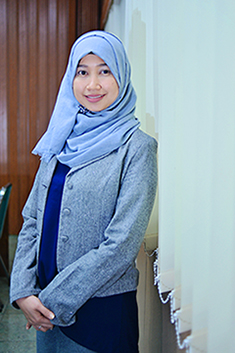Molecular Docking of Bicycloproline Derivative Synthetic Compounds on Envelope Protein: Anti-SARS-CoV-2 Drug Discovery
Downloads
Background: Although a SARS-CoV-2 vaccine is readily available, new cases of COVID-19 are still occurring. New drug discovery is needed to treat COVID-19. Protein E is one of the potential targets. Two synthetic compounds of bicycloproline derivatives have the potential to be developed. Objective:This study aimed to estimate the interaction of bicycloproline compounds to protein E in-silico.Methods:There were two bicycloproline-derived compounds, MI-09 and MI-30, used in docking. Remdesivir was used as a reference ligand. The crystal structure of the E protein was created using homology modeling, while the test compound was drawn using the Marvin Sketch. MOE 2022.02 and BDS 2021 were used for docking and visualization processes. Results:The pentamer of the SARS-CoV-2 E protein obtained a clash score (1.06); poor rotatomer (0.00%); favored rotamers (98.11%); Ramachandran favored (96.43%); Ramachandran outlier (1.78%); Rama Z-score (-1.08); and mol probity (1.04). Research shows promising inhibition potential of the MI-09 and MI-30. The MI-30 has the best binding energy of -10.3326 kcal/mol. Conclusion: The docking results show that MI-30 has potency as an inhibitor of protein E and can be developed in treating COVID-19. Further research is needed to confirm the result by in vitro and in vivo studies.
Abdelrahman, Z., Li, M., & Wang, X. (2020). Comparative Review of SARS-CoV-2, SARS-CoV, MERS-CoV, and Influenza A Respiratory Viruses. Frontiers in Immunology, 11(September). https://doi.org/10.3389/fimmu.2020.552909
Afriza, D., Suriyah, W. H., & Ichwan, S. J. A. (2018). In silico analysis of molecular interactions between the anti-apoptotic protein survivin and dentatin, nordentatin, and quercetin. Journal of Physics: Conference Series, 1073(3). https://doi.org/10.1088/1742-6596/1073/3/032001
Agnihotry, S., Pathak, R. K., Singh, D. B., Tiwari, A., & Hussain, I. (2022). Protein structure prediction. Bioinformatics, 177–188. https://doi.org/10.1016/B978-0-323-89775-4.00023-7
Alsaadi, E. A. J., & Jones, I. M. (2019). Membrane binding proteins of coronaviruses. Future Virology, 14(4), 275. https://doi.org/10.2217/FVL-2018-0144
Asmara, A. P., & Dwi. (2015). Analisis Hubungan Kuantitatif Struktur Dan Aktivitas Senyawa Turunan Triazolopiperazin Amida Menggunakan Metode Semiempirik AM1. Elkawnie, 1(2), 125–138.
Baek, M., Park, T., Heo, L., Park, C., & Seok, C. (2017). GalaxyHomomer: a web server for protein homo-oligomer structure prediction from a monomer sequence or structure. Nucleic Acids Research, 45(W1), W320–W324. https://doi.org/10.1093/NAR/GKX246
Bordoli, L., Kiefer, F., Arnold, K., Benkert, P., Battey, J., & Schwede, T. (2009). Protein structure homology modeling using SWISS-MODEL workspace. Nature Protocols, 4(1), 1–13. https://doi.org/10.1038/NPROT.2008.197
Boson, B., Legros, V., Zhou, B., Siret, E., Mathieu, C., Cosset, F.-L., Lavillette, D., & Denolly, S. (2021). The SARS-CoV-2 envelope and membrane proteins modulate maturation and retention of the spike protein, allowing assembly of virus-like particles. The Journal of Biological Chemistry, 296, 100111. https://doi.org/10.1074/JBC.RA120.016175
Chen, V. B., Arendall, W. B., Headd, J. J., Keedy, D. A., Immormino, R. M., Kapral, G. J., Murray, L. W., Richardson, J. S., & Richardson, D. C. (2010). MolProbity: all-atom structure validation for macromolecular crystallography. Acta Crystallographica Section D: Biological Crystallography, 66(Pt 1), 12. https://doi.org/10.1107/S0907444909042073
Chernyshev, A. (2020). Pharmaceutical targeting the envelope protein of SARS-CoV-2: the screening for inhibitors in approved drugs. ChemRxiv, 1–13. https://chemrxiv.org
Das, G., Das, T., Chowdhury, N., Chatterjee, D., Bagchi, A., & Ghosh, Z. (2021). Repurposed drugs and nutraceuticals targeting envelope protein: A possible therapeutic strategy against COVID-19. Genomics, 113(1), 1129–1140. https://doi.org/10.1016/J.YGENO.2020.11.009
Dassault Systèmes. (2021). BIOVIA DISCOVERY STUDIO VISUALIZAION (No. 2021). Dassault Systèmes. https://3ds.com/products-services/biovia/products
Dey, D., Borkotoky, S., & Banerjee, M. (2020). In silico identification of Tretinoin as a SARS-CoV-2 envelope (E) protein ion channel inhibitor. Computers in Biology and Medicine, 127, 104063. https://doi.org/10.1016/J.COMPBIOMED.2020.104063
Du, X., Li, Y., Xia, Y. L., Ai, S. M., Liang, J., Sang, P., Ji, X. L., & Liu, S. Q. (2016). Insights into Protein–Ligand Interactions: Mechanisms, Models, and Methods. International Journal of Molecular Sciences, 17(2). https://doi.org/10.3390/IJMS17020144
National Library of Medicine. (n.d.). Envelope Protein [Severe acute respiratory syndrome coronavirus 2] - Protein - NCBI. Retrieved April 1, 2022, from https://www.ncbi.nlm.nih.gov/protein/QHD43418.1?report=fasta
Fiser, A. (2010). Template-Based Protein Structure Modeling. Methods in Molecular Biology (Clifton, N.J.), 673, 73. https://doi.org/10.1007/978-1-60761-842-3_6
Gö Tte, M. (2021). Remdesivir for the treatment of Covid-19: the value of biochemical studies. https://doi.org/10.1016/j.coviro.2021.04.014
Hariono, M., Abdullah, N., Damodaran, K. v., Kamarulzaman, E. E., Mohamed, N., Hassan, S. S., Shamsuddin, S., & Wahab, H. A. (2016). Potential New H1N1 Neuraminidase Inhibitors from Ferulic Acid and Vanillin: Molecular Modelling, Synthesis and in Vitro Assay. Scientific Reports 2016 6:1, 6(1), 1–10. https://doi.org/10.1038/srep38692
Heo, L., Park, H., & Seok, C. (2013). GalaxyRefine: protein structure refinement driven by side-chain repacking. Nucleic Acids Research, 41(W1), W384–W388. https://doi.org/10.1093/NAR/GKT458
Homology Modeling. (n.d.). Retrieved August 3, 2022, from https://www.umass.edu/molvis/workshop/homolmod.htm#readymade
Itoh, Y., Nakashima, Y., Tsukamoto, S., Kurohara, T., Suzuki, M., Sakae, Y., Oda, M., Okamoto, Y., & Suzuki, T. (2019). N+-C-H···O Hydrogen bonds in protein-ligand complexes. Scientific Reports, 9(1). https://doi.org/10.1038/S41598-018-36987-9
Jo, S., Kim, S., Shin, D. H., & Kim, M.-S. (2019). Inhibition of SARS-CoV 3CL protease by flavonoids. Https://Doi.Org/10.1080/14756366.2019.1690480, 35(1), 145–151. https://doi.org/10.1080/14756366.2019.1690480
Khader, A., & Mohideen, S. (2021). Molecular Docking Analysis of Phytochemical Thymoquinone as a Therapeutic Agent on SARS-Cov-2 Envelope Protein Molecular Docking Analysis of Phytochemical Thymoquinone as a Therapeutic Agent on SARS-Cov-2 Envelope Protein View project Molecular Docking An. 11(1), 8389–8401. https://doi.org/10.33263/BRIAC111.83898401
Klebe, G. (2013). Protein–Ligand Interactions as the Basis for Drug Action. Drug Design, 61–88. https://doi.org/10.1007/978-3-642-17907-5_4
Komari, N., Hadi, S., & Suhartono, E. (2020). Pemodelan Protein dengan Homology Modeling menggunakan SWISS-MODEL. Jurnal Jejaring Matematika Dan Sains, 2(2), 65–70. https://doi.org/10.36873/JJMS.2020.V2.I2.408
Li, L., & Huang, S. (2021). Newly synthesized Mpro inhibitors as potential oral anti-SARS-CoV-2 agents. Signal Transduction and Targeted Therapy, 6(1), 3–4. https://doi.org/10.1038/s41392-021-00560-0
M, T. U. Q., SM, A., MA, A., & LL, C. (2020). Structural basis of SARS-CoV-2 3CL pro and anti-COVID-19 drug discovery from medicinal plants. Journal of Pharmaceutical Analysis, 10(4), 313–319. https://doi.org/10.1016/J.JPHA.2020.03.009
Mohamad Rosdi, M. N., Mohd Arif, S., Abu Bakar, M. H., Razali, S. A., Mohamed Zulkifli, R., & Ya'akob, H. (2017). Molecular docking studies of bioactive compounds from Annona muricata Linn as potential inhibitors for Bcl-2, Bcl-w and Mcl-1 antiapoptotic proteins. Apoptosis 2017 23:1, 23(1), 27–40. https://doi.org/10.1007/S10495-017-1434-7
N Baker, B. E. (2006). 22.2. Hydrogen bonding in biological macromolecules.
Pace, C. N., Fu, H., Fryar, K. L., Landua, J., Trevino, S. R., Shirley, B. A., Hendricks, M. M. N., Iimura, S., Gajiwala, K., Scholtz, J. M., & Grimsley, G. R. (2011). Contribution of Hydrophobic Interactions to Protein Stability. Journal of Molecular Biology, 408(3), 514. https://doi.org/10.1016/J.JMB.2011.02.053
Panigrahi, S. K., & Desiraju, G. R. (2007). Strong and weak hydrogen bonds in the protein–ligand interface. Proteins: Structure, Function, and Bioinformatics, 67(1), 128–141. https://doi.org/10.1002/PROT.21253
Park, S. H., Siddiqi, H., Castro, D. v., de Angelis, A. A., Oom, A. L., Stoneham, C. A., Lewinski, M. K., Clark, A. E., Croker, B. A., Carlin, A. F., Guatelli, J., & Opella, S. J. (2021). Interactions of SARS-CoV-2 envelope protein with amilorides correlate with antiviral activity. PLOS Pathogens, 17(5), e1009519. https://doi.org/10.1371/JOURNAL.PPAT.1009519
Patrick, G. L. (2013). An Introduction to Medicinal Chemistry Fifth Edition. In Oxford University Press (5th Ed). OXFORD. https://doi.org/10.1016/0307-4412(76)90096-0
Pervushin, K., Tan, E., Parthasarathy, K., Lin, X., & Jiang, F. L. (2009). Structure and Inhibition of the SARS Coronavirus Envelope Protein Ion Channel. PLoS Pathog, 5(7), 1000511. https://doi.org/10.1371/journal.ppat.1000511
Prajapat, M., Sarma, P., Shekhar, N., Avti, P., Sinha, S., Kaur, H., Kumar, S., Bhattacharyya, A., Kumar, H., Bansal, S., & Medhi, B. (2020). Drug targets for corona virus: A systematic review. Indian Journal of Pharmacology, 52(1), 56. https://doi.org/10.4103/IJP.IJP_115_20
Qiao, J., Li, Y.-S., Zeng, R., Liu, F.-L., Luo, R.-H., Huang, C., Wang, Y.-F., Zhang, J., Quan, B., Shen, C., Mao, X., Liu, X., Sun, W., Yang, W., Ni, X., Wang, K., Xu, L., Duan, Z.-L., Zou, Q.-C., ... Yang, S. (2021). SARS-CoV-2 Mpro inhibitors with antiviral activity in a transgenic mouse model. Science, 371(6536), 1374–1378. https://doi.org/10.1126/SCIENCE.ABF1611
Ramasami, P. (2020). Computational Chemistry Methods: Applications (P. Ramasami, Ed.). De Gruyter. https://doi.org/https://doi.org/10.1515/9783110631623
Schoeman, D., & Fielding, B. C. (2019). Coronavirus envelope protein: current knowledge. Virology Journal 2019 16:1, 16(1), 1–22. https://doi.org/10.1186/S12985-019-1182-0
Schoeman, D., & Fielding, B. C. (2020). Is There a Link Between the Pathogenic Human Coronavirus Envelope Protein and Immunopathology? A Review of the Literature. Frontiers in Microbiology, 0, 2086. https://doi.org/10.3389/FMICB.2020.02086
Sergeev, Y. v., Dolinska, M. B., & Wingfield, P. T. (2014). The thermodynamic analysis of weak protein interactions using sedimentation equilibrium. Current Protocols in Protein Science / Editorial Board, John E. Coligan ... [et Al.], 77, 20.13.1. https://doi.org/10.1002/0471140864.PS2013S77
Sharma, S., Sarkar, S., Paul, S. S., Roy, S., & Chattopadhyay, K. (2013). A small molecule chemical chaperone optimizes its unfolded state contraction and denaturant like properties. Scientific Reports, 3. https://doi.org/10.1038/SREP03525
Siswandono. (2016). Medicinal Chemistry (Siswandono, Ed.; 2nd ed.). Airlangga University Press.
Torres, J., Parthasarathy, K., Lin, X., Saravanan, R., Kukol, A., & Ding, X. L. (2006). Model of a Putative Pore: The Pentameric α-Helical Bundle of SARS Coronavirus E Protein in Lipid Bilayers. Biophysical Journal, 91(3), 938. https://doi.org/10.1529/BIOPHYSJ.105.080119
Woo, P. C. Y., Huang, Y., Lau, S. K. P., & Yuen, K. Y. (2010). Coronavirus Genomics and Bioinformatics Analysis. Viruses, 2(8), 1804. https://doi.org/10.3390/V2081803
Zhang, L., Lin, D., Sun, X., Rox, K., & Hilgenfeld, R. (2020). X-ray Structure of Main Protease of the Novel Coronavirus SARS-CoV-2 Enables Design of α-Ketoamide Inhibitors. BioRxiv, 2020.02.17.952879. https://doi.org/10.1101/2020.02.17.952879
Copyright (c) 2023 JURNAL FARMASI DAN ILMU KEFARMASIAN INDONESIA

This work is licensed under a Creative Commons Attribution-NonCommercial-ShareAlike 4.0 International License.
1. The copyright of this journal belongs to the Editorial Board and Journal Manager with the author's knowledge, while the moral right of the publication belong to the author.
2. The formal legal aspect of journal publication accessibility refers to the Creative Commons Attribution-Non-Commercial-Share Alike (CC BY-NC-SA), which implies that the publication can be used for non-commercial purposes in its original form.
3. Every publication (print/electronic) is open access for educational, research, and library purposes. In addition to the objectives mentioned above, the editorial board is not responsible for copyright infringement


.jpg)















